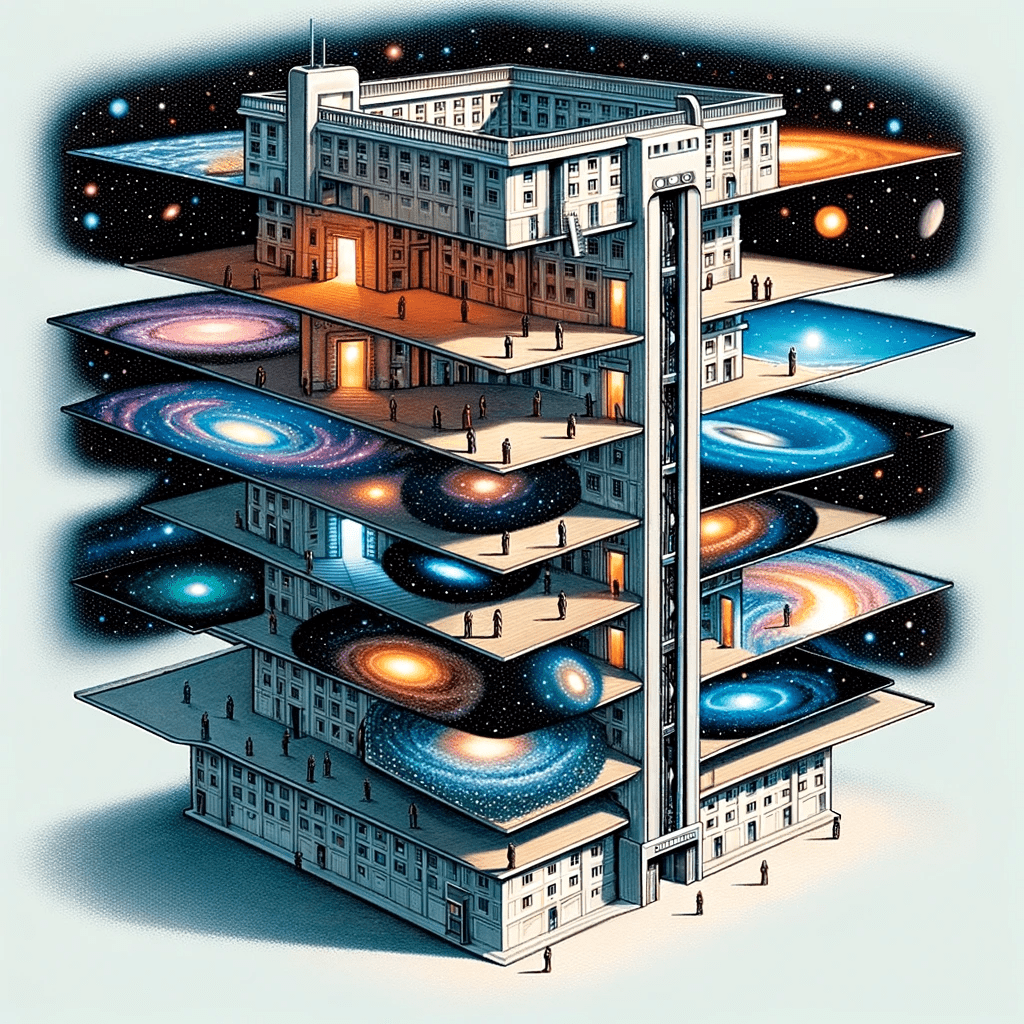Brane-World Scenario

The brane-world scenario, a theoretical concept grounded in string theory and M-theory, posits that our known universe might just be a single “floor” in a multi-dimensional “building.” Each floor in this building serves as a metaphorical stand-in for a brane, or a universe, complete with its own set of physical laws and constituents. Some theories even suggest that forces like gravity could move between these branes, much like an elevator traversing multiple floors in a building. Despite its conceptual allure, it’s important to clarify that the brane-world scenario remains a speculative idea within the scientific community, pending empirical validation.
Imagine a multi-story building where each floor represents a different “brane,” or universe. The people living on each floor go about their lives, mostly unaware of the other floors. However, the building’s elevator (which could represent gravity or other fundamental forces) can move between all floors. Some floors might have unique characteristics, like different lighting or furniture (akin to different physical laws or constants), but the elevator can interact with them all.
In this analogy, each floor is a brane-universe existing in a higher-dimensional “bulk” (the entire building). The elevator that can move between floors represents how certain interactions or particles, like gravitons in some brane-world scenarios, could move through the higher-dimensional space, affecting multiple branes.
In the building analogy, the “bulk” would be the entire structure of the building itself, including all the floors, the elevator shaft, the stairwells, and even the spaces between floors. It’s the higher-dimensional space that encompasses all the individual “branes” (floors).
In brane-world theories, our 3D universe (3 spatial dimensions and 1 time dimension, making it 4D spacetime) could be a single brane embedded in a higher-dimensional space. This higher-dimensional space could have more than the four dimensions we are familiar with. The extra dimensions would be part of the “bulk,” and they might allow for other branes—other “universes”—to exist parallel to our own.
Just as the elevator can move through this larger structure, interacting with each floor, particles or forces like gravity in the brane-world scenario could move through the “bulk,” interacting with multiple branes (universes). The building structure that contains all the floors is the space in which all these individual universes (floors) are embedded.
In the building analogy, the elevators could be named based on the fundamental forces or hypothetical interactions that have the potential to operate across different branes in higher-dimensional space. Here are some elevators that could be relevant:
- Gravity Elevator: This would be the most discussed elevator, as many brane-world scenarios suggest that gravity could leak out of our own brane and interact with other branes.
- Electromagnetic Elevator: While less commonly proposed to interact between branes, electromagnetic forces are a fundamental part of our universe and could be included for completeness.
- Strong Nuclear Force Elevator: This force holds atomic nuclei together and is immensely powerful but operates over very short distances. It’s typically not considered a candidate for brane-to-brane interaction, but it’s a fundamental force.
- Weak Nuclear Force Elevator: Responsible for processes like radioactive decay, the weak force is another cornerstone of particle physics.
- Hypothetical Particle Elevator: This could represent theorized but yet undiscovered particles that might have the ability to move between branes. Examples could include candidates for dark matter or other exotic particles.
- Dark Energy Elevator: If you’re considering cosmic phenomena, an elevator for the mysterious dark energy that’s driving the accelerated expansion of the universe could be added.
- Quantum Elevator: This could represent the realm of quantum mechanics, which introduces elements of uncertainty and entanglement. Some theories speculate that quantum entanglement might have implications in higher-dimensional space.
- Cosmic Strings Elevator: In some theories, cosmic strings (not to be confused with string theory) are hypothesized to be narrow tubes of energy left from the early cosmos. These could also potentially interact across branes.
- Wormhole Elevator: For a touch of speculative physics, an elevator representing hypothetical tunnels or “shortcuts” through spacetime could be included.
The “Wormhole Elevator” in the building analogy can serve as a representation of theoretical physics: wormholes. In the context of brane-world theories, the idea of wormholes suggests that these “shortcuts” through spacetime could exist as connections between different branes or even distant locations within a single brane.
The allure of wormholes primarily comes from their theoretical potential to enable faster-than-light travel, thereby making interstellar or even inter-brane journeys conceivable. If wormholes can link different branes or remote sections of a single brane, they would serve as the ultimate “elevators,” instantly transporting matter and information across unimaginable distances. This is where the idea intersects with speculations around Unidentified Aerial Phenomena (UAP) and Unidentified Flying Objects (UFOs).
Many theories and reports surrounding UAPs or UFOs suggest that their observed capabilities—sudden acceleration, abrupt changes in direction, and other maneuvers that seem to defy known laws of physics—could be explained by advanced propulsion technologies or even manipulation of spacetime. In such speculative scenarios, the “Wormhole Elevator” offers a framework for imagining how these objects might traverse vast distances almost instantaneously.
The “Wormhole Elevator” makes for an engaging and thought-provoking addition to the brane-world building analogy, its inclusion is primarily rooted in speculation and theoretical extrapolation.
The brane-world scenario is a theoretical framework rooted in string theory and its extensions, such as M-theory. These theories propose that the universe is not merely composed of point-like particles but may include one-dimensional “strings” or higher-dimensional “branes” as its fundamental components. While the mathematical models are robust and offer exciting avenues for exploration, it’s crucial to note that, as of now, these theories lack empirical evidence.
In the building analogy, we discussed how different floors could have unique features like distinct lighting or furniture. Extending this, imagine that some floors operate under completely different building codes, perhaps even obeying different laws of physics altogether. In the same way, different branes in a brane-world scenario might not just have different constants but could host entirely unique particles and forces, offering a multitude of universes with varying characteristics.
If a parallel universe or “brane” had significantly different physical laws, the types of celestial bodies that could form might also be vastly different. For example, if the fundamental forces like gravity or electromagnetism behaved differently, the processes governing planet formation, star formation, and even the basic structure of matter could be unlike anything we observe in our universe.
Even in a scenario where the physical laws are similar but initial conditions vary, the exact configuration of planets, stars, and galaxies could be unique to each universe. In this sense, even though there might be statistical similarities between multiple universes, each could also possess its own unique set of celestial bodies.
One of the strengths of some brane-world theories is that they offer testable predictions. For instance, these theories could account for deviations from well-established physical laws at certain scales or energies. The possibility of verifying these predictions through experiments—such as particle collisions at high energies—adds credibility to the brane-world concept and elevates it beyond mere speculation.
While the multi-story building analogy serves as an excellent introductory explanation, it has its limitations. Most notably, the analogy fails to capture the inherent mathematical complexity and higher-dimensional geometry of the brane-world theories. Real-world implementations involve intricate mathematical models that are far more complex than a simple building structure, offering solutions to equations that cannot be easily visualized.
There are still many open questions in the realm of brane-world theories. One of the most intriguing is why gravity is so much weaker compared to other fundamental forces like electromagnetism. Some brane-world models suggest that gravity may be “diluted” in higher dimensions, leading to its observed weakness in our own 3D universe. This, among other questions, remains a key focus of ongoing research.
The brane-world scenario has profound implications for our understanding of the cosmos. It offers alternative viewpoints for the origin of the universe, potentially rewriting narratives about the Big Bang. It could also have far-reaching impacts on future cosmological research, influencing how we study everything from black holes to the ultimate fate of the universe.
The brane-world model serves as a framework that potentially revolutionizes our understanding of space, time, and the very fabric of reality. It introduces the tantalizing possibility of other universes coexisting with ours in a higher-dimensional space known as the “bulk.” Beyond the conceptual appeal, these theories offer testable predictions, inviting future research and experimental validation.



